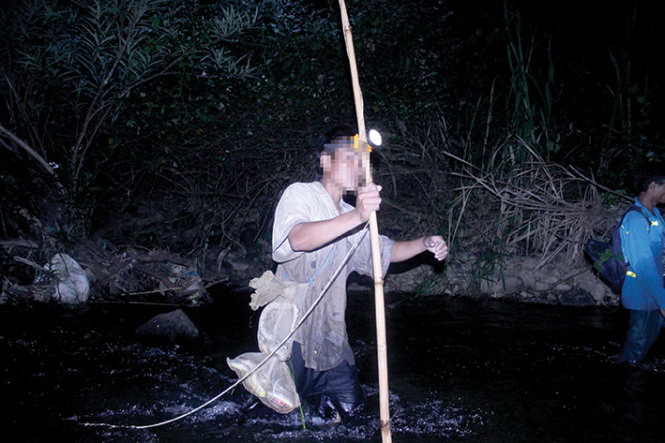A number of ethnic minority men from the Central Highlands province of Lam Dong have been making a living hunting snakes, including venomous ones, in a strip of forbidden forest for over a decade now.
As night falls, men from the Chau Ma and S’tieng ethnic minority groups will leave their hamlets inside a strictly protected area of Cat Tien National Park and head toward the springs.
The park spans a vast area around 170km from the popular resort town of Da Lat, and crosses the borders of the two neighboring provinces of Dong Nai and Binh Phuoc.
The hunting daredevils catch various species of snake, including venomous ones, using only their bare hands or simple tools.
The reptiles are then sold to restaurant owners as food or are fermented in alcohol as a ‘potion’ or ornament.
Several fetch high prices as they are claimed to possess medicinal properties, including the ability to cure cancer.
Hunters stick to their job to earn money and support their families despite the risk of snakebites.
Tuoi Tre (Youth) newspaper journalists recently joined a group of the snake stalkers to acquire an understanding of their job.
According to K’Hoang, one of the group members, residents rely heavily on forest resources after harvest; picking wild vegetables by day and hunting for snakes by night.
The group traveled around 10 kilometers from their hamlet to reach an area teeming with their catch.
Non-poisonous serpents such as grass snakes, colubrid snakes, sunbeam snakes and venomous ones including king cobras, dendrophis, monocled cobras, as well as pythons are most sought-after by the group.
All 11 of the group members catch the non-poisonous snakes with their bare hands, while using simple tools such as home-made clamps, sacks, nets, torches, and bush hooks to grasp venomous ones.
They also take along their home-made alcohol guns, the use of which has been banned given the risks involved.
The gun looks similar to a rifle, but its two cartridge holders are in the butt, which contains alcohol gas. Its trigger is an electric spark.
 |
| K'Hoang pulls a snake from a tree with his bare hands. Photo: Tuoi Tre |
Bullets, which are ball-bearings from a bike, are applied directly from the barrel.
“I buy a few pipe segments to build the gun, and disassemble it after I’m done with the hunt. So no one really knows,” K’Hoang divulged.
Beneath the cloak of darkness, the group continued to trek upstream, with the sounds made by nocturnal animals heard from afar.
K’Niep, still in his early 30s, is a veteran hunter.
The back of his hand is riddled with scars gained from attempting to grab the snakes hidden in the shrubs.
It takes great courage wading upstream in the black of night to reach the snakes' dens.
“We stay alert all the time while crossing the streams, and have to jump out of the water as quickly as we can if we notice a strange noise or feel stronger currents. Floodwaters can surge without warning and flush all of us away,” K’Niep cautioned.
According to the hunters, they need to shine their flashlights at the shrubs.
The snakes, which swarm the area at night to stalk on their own prey, leave themselves exposed because their tails and torsos reflect the light.
Walking along, K’Hoang suddenly let out a whistle as he spotted a coiling python on a branch about three meters above the ground.
Moving quickly, K’Hoang adeptly catches the reptile’s head using his clamp.
The python, weighing about 3kg, then frantically slid into a nearby spring where K’Niep was waiting to ambush it.
“Boas of 10kg or above can easily wind their long body around a human adult and crush them to death. Those who are lucky to survive will still suffer critical injuries, mostly bone fractures,” K’Hoang noted.
K’Dieu, another group member, recalled a time that he and several other villagers spotted a king cobra several months earlier.
When he and another hunter tried to grip its head, the reptile jerked free and attacked them.
The angered snake ran after its hunters, causing them to flee in panic.
K’Hoang then recalled another instance in which a novice was bitten by a venomous snake after he had tried to capture the reptile with his bare hands, having mistaken it for a non-poisonous one.
K’Hoang briskly tied a string around the bite to stop the flow of venom and rushed him on his back to hospital.
“We do the job for a living. The more venomous the snake is, the more expensive it is. Picking vegetables from the forests, which is typically done by women, is not enough to provide for our family,” K’Niep shared.
 |
| The hunters' catch includes several snakes, a boa and three iguanas. Photo: Tuoi Tre |
The group also captured other wild animals including fowls, lizards and iguanas, which they spotted during the night’s hunt.
“We sell the snakes and other animals which fetch high prices and split the money, and kill the low-value ones for food,” K’Dieu, 31, said.
On the night in question, the group managed to catch five snakes, a python and three iguanas.
“The expensive species are much harder to find now. Big ones can fetch a few million dong [VND1 million is equivalent to US$44] apiece,” he revealed, admitting to have been on the job for around 10 years.
Tuoi Tre’s investigation revealed that snake prices fluctuate between VND400,000 ($18) and VND1.2 million ($52) per kilogram.
According to the Lam Dong Forest Ranger Department, in addition to Cat Tien National Park, poachers and residents also hunt in neighboring districts Da Teh and Da Huoai.
A wildlife conservation officer in Cat Tien Park put the rampant illegal activity down to slack forest ranging and a forest management paradox.
Some thousand households have called Cat Tien Park home for years.
“A relocation plan has been delayed due to a lack of funding. It’s thus difficult to keep hunting in check as the residents live inside the strictly protected forest and rely on its resources for their livelihood,” he noted.
Nguyen Khang Thien, head of the provincial Forest Ranging Department, said that rangers had busted eight wildlife trading cases and seized 32 snakes and boas in the first six months of 2017.
Poachers can be fined between VND500,000 ($22) and VND400 million ($17,493) depending on the number and species of snakes they catch.
Many varieties of snake in Cat Tien and other forests south of Lam Dong have been listed in the IIB category, which means restricted exploitation for commercial use, Thien added.
Like us on Facebook or follow us on Twitter to get the latest news about Vietnam!



















































